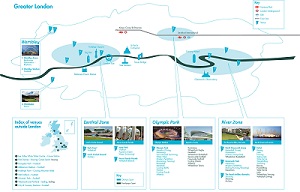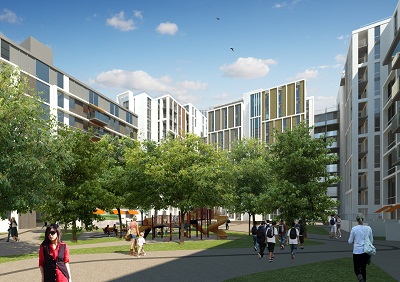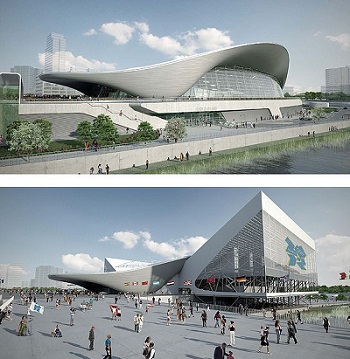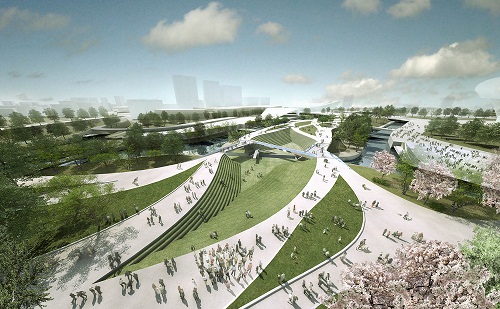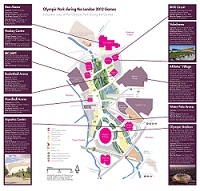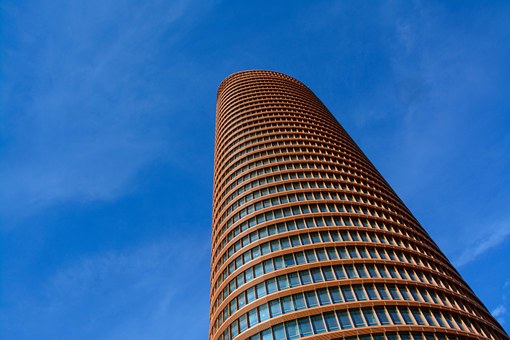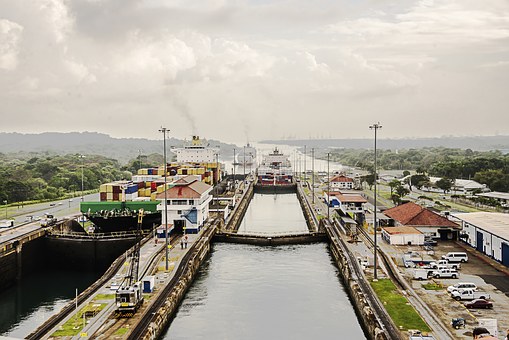The Olympic Games are the world’s largest international athletic competition. Every two years, viewers from around the globe tune in to the Olympics to cheer on their nations’ most celebrated athletes. The heroic athletic performances of the Olympics will always be remembered, but what is often forgotten is the incredible preparation effort completed by each host city. London is the latest city to be crowned as an Olympic host and is already well into preparations for the 2012 Olympic Games. Engineers from all disciplines are at the heart of the effort and will play a crucial role in ensuring the London Olympics run smoothly, in hopes that London be portrayed as a modern, majestic city. Specifically, engineers are focusing on the preparation of the Olympic Park site, construction of housing and athletic facilities, improvement of London’s transportation infrastructure, and integration of preventative measures against possible terrorism threats.
Introduction
Every two years, the eyes of billions from around the globe descend upon one city to watch the world’s greatest international athletics event: The Olympic Games. In the winter of 2010, we intently watched as the world’s top athletes gathered in Vancouver to compete in and celebrate international competition. In light of the recent Games, we look forward to the next exhilarating gathering of the crème de la crème of international athletes, this time in 2012 in London, England, for the Summer Olympic Games (see Fig. 1), officially known as the Games of the XXX Olympiad.
In 2005, London outlasted some of the world’s greatest cities in Olympic host city voting, including Paris and New York City, and was named the host of the 2012 Olympic Games, immediately leading to parties and celebrations breaking out all across the United Kingdom. In the days that followed, engineers broke ground on Olympic preparations.
At the center of the celebrations and competition among the world’s great cities is the fundamental question: Why do cities care so much about hosting the Olympic Games? Aside from the obvious excitement of having the world’s greatest athletes on your home turf, the Olympics have the potential to revitalize an entire city, and even country. Olympic spending has skyrocketed in recent years, with the estimated spending of the 2012 London Olympics ($12 billion) being approximately 150 times greater the Olympic spending by Los Angeles in 1984 ($75 million) (see Fig. 2).
Countries take advantage of hosting the Olympics to improve their own infrastructure, kick start their economies, and carry out civil projects that never would have happened otherwise. No other event can demand the world’s attention like the Olympics can, and for that reason countries today pour billions of dollars into the Olympic preparation effort to ensure their city draws the awe of the world for a magical two and a half week competition.
However, before hosting the grandeur that is the Olympic Games, London must carry out an incredible preparation plan. We will now explore London’s preparation in four key areas: choosing the Olympic Park site, constructing new facilities, improving transportation infrastructure, and combating terrorism. Furthermore, we will discuss how engineers are truly at the heart of each and every aspect of the preparation.
Olympic Park Site
A crucial part of London’s Olympic Plan was the construction of an Olympic Park to serve as the central hub of London’s Olympic effort. The currently in-construction Olympic Park includes housing for Olympic participants and competition venues such as the Olympic Stadium and Aquatics Center. However, given London’s densely-packed nature, finding a site for such a gargantuan park proved to be no easy task. London is a fully-developed city that has been around for two millennia, and, as a result, there are simply no undeveloped areas available to serve as the home of the Olympic Park. After weighing their options, London’s organizers made the bold decision to designate a previously industrial area in Stratford, in the East End of London, as the construction site, prior to winning the Olympic bid (see Fig. 3) [1].
Upon the news of winning the Olympic bid in 2005, chemical and environmental engineers set about cleansing the soil and waterways of the region, which had been heavily polluted by chemicals after years of industrial use, through a process called bioremediation [2]. The process of bioremediation involves the implementation of cleansing fungi, plants, microorganisms, and enzymes into existing ecosystems requiring cleaning; for more information about bioremediation techniques, click here to check Illumin’s article on phytoremediation . Each organism involved in bioremediation targets certain contaminants in the soil; for example, engineers used fertilizers with high nitrate and sulfate content in order to decompose crude oil industrial waste.
For the Olympic Park site in particular, organizers have implemented complex soil washing plants on site. First, soil is excavated and screened for large (>5 cm diameter) particles of heavy metals, plastics, and rocks. Then, the soil passes through secondary chemical treatment plants in which it is sorted into four different output groups using electromagnetic technology: sand (>2 mm), gravel (<50 mm), fine silts and clays, and fine organic matter (plants, coal, etc.). The groups are then treated for contaminants individually. After treatment, the four output groups are combined in different ratios to produce soil with varying structural stability. The soil is then replaced as desired to allow for the stable construction and planning of buildings by civil engineers.
For waterways, engineers have instituted a combination of organic and mechanical treatment approaches. On the organic side, chemical engineers have introduced microorganisms that break down surface oil and other contaminants in the water. Mechanically, hydraulic pumps have been installed to filter the water, similar to the way in which filtering technology is used to rid swimming pools of contaminants. The majority of the work involving the cleansing of waterways and soil has been completed, as building construction is now fully underway.
Environmental engineers have also given the area a ‘green’ makeover on a larger, more visible scale. By the time of the Games, over 4,000 trees and 300,000 wetland plants will be planted in the Olympic Park, further adding to the environmental improvement of the region [1]. Engineers will also artificially introduce numerous different miniature ecosystems and landscapes across the park, including parklands, meadows, ponds, and wet woodlands, to welcome wildlife from all over England [1].
By the time of the Olympics, the Olympic Park site is expected to contain 127 hectares (313.8 acres) of new, environmentally-friendly urban parkland, featuring clean waterways and wetlands serving as home to many species of native wildlife [3]. The Olympic Park will serve as the most impressive of London’s green efforts in preparation for the coming Olympics [4].
Facilities Construction
As with all Olympic Games, one of the most significant logistical problems London faces is ensuring the completed construction of all necessary facilities to host Olympic events and sufficient housing for its 17,000 Olympic participants. On the event side, London had a more difficult job than most host cities because only the tennis venue, the famed Wimbledon Racquet Club, existed prior to Olympic construction [5]. Thus, much new construction was needed, especially in the Olympic Park, to complete the Olympic Stadium, Aquatics Centre, and Olympic Village (see Fig. 4) [1].
Olympic Village
On the Eastern edge of Stratford’s Olympic Park, engineers designed a giant apartment complex to serve as the Olympic Village, housing the majority of Olympic participants (see Fig. 5). Civil engineers designed the living area with the future in mind, as London planners hope that the apartments will be attractive living option for future Stratford residents, transforming the region from its industrial roots into a chic urban living option [5].
Early on, London’s Olympic organizers decided that the majority of Olympic athletic venues, including the Olympic Stadium Aquatics Centre, Sports Arena, and Velodrome (cycling stadium), would be constructed within the Olympic Park. Engineers and architects were able to plan and execute construction of these Olympic Park venues such as the Olympic Stadium and Sports Arena with relative ease for such large structures due to their mostly conventional architecture [6]. However, construction of the Aquatics Centre (see Fig. 6), which will house a diving pool and two 50 meter swimming pools, has been an entirely different story. Largely due to its innovative waveform roof designed by renowned architect Zaha Hadid, the Aquatics Centre is serving as both the most challenging and architecturally striking building project of the Olympic preparation process [7].
The roof itself weighs 2,800 tons, has an area of 11,000 sq. ft, and is 160 m in length across its longest diagonal. Seemingly the entire UK has banded together to create the masterpiece of a roof, as different roof components are being manufactured in northern England, Scotland, and Wales [8]. Incredibly, the massive roof will rest solely on two large concrete support columns and a support wall that is 28 m long and 5 m wide. Most impressively, civil engineers, after extensive pre-construction computer modeling and testing components of the roof in a wind tunnel, are constructing the building in such a way that allows for the waveform roof to twist, stretch, and contract slightly in response to changing temperatures and environmental conditions such as rain and snow [8]. Upon completion, the Aquatics Centre will become the crowning symbol of the London Olympics [7].
Transportation Infrastructure
Although London is renowned for its extensive public transportation infrastructure, its transportation system needs to be upgraded to accommodate the throngs of tourists that will be in London during the Games. Today, London is already a city challenged with urban travel congestion, and in recent years it has been doing its best to eliminate cars in the city center, even implementing a heavy tax system for cars driven during the workweek [9]. The transportation challenge faced by London is two-fold, with half of the effort concentrated on city-wide and intra-city travel, and the other half concentrated on eliminating traffic congestion in the Olympic Park and immediate surrounding areas [10].
Greater London
Many Olympic experts feel that what set London apart from other potential host cities when vying for a bid back in 2005 was London’s proposed Olympic transportation system [11]. During the Games, most fans and event attendees will not be staying within walking distance of the Olympic Park or other Olympic venues, and thus will need access to public transportation [12].
London pledges to have the most fan accessible Olympic Park in the history of the modern games [10]. By the time of the Games in 2012, ten separate railway lines will connect the Olympic Park to all parts of London [11]. Transportation engineers estimate that when all lines are fully operational, Stratford’s main station will accommodate the arrival of 240,000 passengers per hour, an absolutely astounding feat of engineering that will hopefully relieve a significant amount of street traffic.
Two of the largest contributors to this transportation efficiency will be the Olympic Javelin and Eurostar. The first, the in-construction Olympic Javelin, is a railway consisting of 12-car trains that can travel up to 225 km/hour. The Javelin will remarkably connect Stratford to two of London’s largest stations, King’s Cross/St. Pancras and Kent, in seven and ten minutes, respectively [11]. Eurostar, unlike the Olympic Javelin, deals with more distant travel, facilitating passenger movement from Paris and Brussels to the Stratford Olympic station. Both trips, from Paris and Brussels, will take approximately two hours, a feat that significantly added to London’s transportation resume.
Even with London’s incredible rail additions, street travel was still an issue faced by London’s transportation engineers. In response, London has revved up its public bus system to accommodate the coming Olympics and the people the Games will bring. Most notably, London will be utilizing hundreds of new hybrid buses to transport eager Olympic fans to and from their favorite venues. Although the buses will appear on the outside to be in London’s classic red double decker buses, they will actually be hybrid buses designed by BAe Systems in New York. Not only will London’s transportation system be one of the most efficient by the time of the Games, it will also be one of the most environmentally friendly [13].
In addition to concerning itself with public transportation on the city-wide level, Olympic organizers are working to prevent potential congestion in the Olympic Park and roads connecting the Olympic Park to other locales. Given that the Olympic site itself comprises multiple waterways and railways that separate regions of the park, the Olympic Delivery Authority has been forced to develop a complex network of bridges, walkways, and roads to bring all the pieces of the park together. New Civil Engineer reports that an example of infrastructure construction are the five new bridges being built to connect the Olympic stadium, which is surrounded on three sides by water, to other areas of the Olympic Park (see Fig. 7). Olympic Delivery Authority Director Simon Wright explains, “These new networks of roads and bridges are already transforming the once fragmented Olympic Park site, [are] creating new links for construction activity and [are] providing the building blocks for an open and accessible Park in 2012 and beyond” [10]. Ultimately, by the time the Games arrive, London will have provided efficient means of travel both on foot and by vehicle for the Olympic Park and immediately surrounding areas [3].
Combating Terrorism
In an article about the forthcoming London Olympics, Elizabeth Renzetti, a writer for the Canadian The Globe and Mail, reported that “international terrorism has been identified as the greatest threat to the 2012 Olympics.” It only takes one security breach or terrorist event to potentially derail the success of an entire Olympic Games [12]. Learning from past tragedies, such as the Centennial Park bombing at the Atlanta Summer Olympics in 1996 and the horrific murder of Israeli athletes during the 1972 Munich Summer Olympics, London’s organizers will utilize all possible resources to keep fans and athletes safe. In addition to the Olympics being especially prone to terrorist attacks, London has already proven to be an attractive terrorist target after falling victim to an attack the day after London had been announced as the host of the 2012 Games [14]. While human security forces may still be at the heart of terrorism in this digital age, London will do its best to combine both human and technological resources to prevent any occurrence of terrorism during the Games.
Human
In terms of human security forces, London will both rely on the military and normal security forces to patrol London during the Games. During one of London’s largest public events, the Notting Hill Carnival, the city typically deploys about 6,000 police officers. However, early reports claim that up to 9,000 police officers will be on patrol at any given time during the 2012 games. Furthermore, up to 5,000 trained security officers will be available to assist police officers. In addition, London is prepared to rely upon military foot soldiers if need be. The human security forces will primarily be involved with ensuring the safety of civilians traveling around the city and the safety of athletes as they move to and from the Olympic Village to the various Olympic venues. Learning from the 2010 Vancouver Olympics, during which many raucous parties arose before and after large events, security personnel will pay special attention to any large crowds that gather before or after events by stationing extra officers around venues for a few hours before and after popular events. London officers aim to maintain a celebratory, relaxed atmosphere while still ensuring that no parties get out of hand [15].
Technology
London will assuredly have a grasp on human-based security by the time the Olympics roll around. However, where London is really separating itself in terms of superior security preparation is through the use of technology. By July 2012, London will have relied on electrical, mechanical, and computer engineers to implement a fully functional fleet of UAVs (Unmanned Aerial Vehicles) to patrol London during the Olympics. UAVs will give security forces a distinct advantage in that they are the most effective manner to gain perspective from above, with high resolution cameras that prove extremely effective in identifying cars and people [16]; for more information on this technology, check out Illumin’s article on
UAVs.
In addition, London will have helicopters and anti-aircraft military defense on call in case of an aerial attack [15]. In implementing a combination of both human and technological resources in the fight against terrorism, London is reducing the chance of any major terrorist attack occurring during the Olympic Games.
Conclusion
By the time the 2012 Summer Olympic Games roll around, London will have endured a seven year long grueling Olympic preparation process. Olympic organizers and engineers will have spent countless hours checking that every preparation in terms of Olympic site, facilities construction, transportation infrastructure, and security has been completed, and London will finally be ready for the big show. Though the Olympic Games will come and go, London will be left with beautiful new athletic facilities, a vastly improved infrastructure, and experience in maintaining public security even in the most hectic events. London will be forever improved, and the focus will shift to Sochi, Russia, host of the 2014 Olympic Games, where assuredly Olympic preparations are already in full swing.
References
-
- [1] International Olympics Committee. London 2012.
- [2] K. Chibber. “Makeover for the East End of London.” The New York Times. Jan. 2009.
- [3] “2012 Olympic Games – Wright on Track.” Builder & Engineer Online, Jan. 2008.
- [4] C. Mayer. “London 2012: Tough Act to Follow.” Time Magazine, Aug. 2008.
- [5] C. Proctor. “CH2M Hill Preparing London for 2012 Olympics.” Denver Business Journal, Feb. 2010.
- [6] A. O’Connor. “Half-time Report on London 2012 Olympics.” Times Newspapers, Jan. 2009.
- [7] K, Smith. “Exclusive: How the London Olympics Aquatics Centre is Being Built.” ContractJournal.com, Jun. 2009.
- [8] R. Watson. “Work Going Swimmingly at London 2012 Aquatics Centre.” JustEngineers.Net, Apr. 2, 2009.
- [9] J.R. Gold and M. M. Gold. “Olympic Cities: City Agendas, Planning, and the Worlds Games: 1896 to 2016.” New York: Routledge, 2007.
- [10] “New Links Around Olympic Park Take Shape as Roads and Bridges Work Accelerates.” New Civil Engineer, Aug. 2009
- [11] “London-2012: London Olympic Transport.” GreenwichMeanTime.co.uk, 2010.
- [12] E. Renzetti. “London Looks to Lessons Learned from Vancouver Olympics.” The Globe and the Mail, Mar. 2010.
- [13] T. Shelley. “New Contenders for 2012 Olympics.” Eureka. Findlay Media: Nov 2008.
- [14] P. Bignell. “Security Bill for London’s 2012 Olympics to hit 1.5 bn – Triple the Original Estimate.” The Independent, Sep. 2008.
- [15] J. Magnay. “London 2012: Up to 9,000 Police Officer to be in Capital as Organizers Aim for Safe Games.” Telegraph, Mar. 2010.
- [16] S. Fox. “British to Monitor Civilians With UAVs by 2012.” Popular Science, Jan. 2010.

